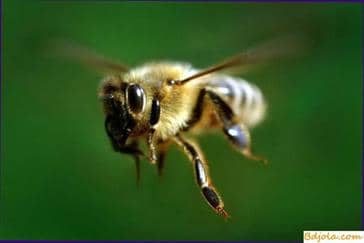What annoys bees

Bees are angry and all the sharp movements are running along the apiary, brushing off the approaching insect, nervous behavior. Obviously, in this they perceive a threat. By the way, the eyes of the bees are arranged so that they instantly perceive the slightest fluctuations and immediately react to them.
If the bees are angry, then they will not escape even the sharp movement of the finger, and they will pounce on the person to sting.
The bees are annoyed with hair, wool, black clothes. In their nests, after all, bears and martens often invaded, having a thick coat. Obviously, the fight against them and developed such an intolerant attitude. Therefore, beekeepers close their heads, put on a white robe or light overalls. White, on the contrary, soothes bees.
The bees are furious with the smell of sweat, spirits, garlic and other unnatural, unpleasant odors. After all, they have a very delicate sense of smell. Their extremely mobile, if hinged, antennae antennae contain a huge number of olfactory pits – locators (6 thousand each), which are able to catch the most insignificant, inaccessible to man shades of aromas. Do not notice the beekeeper, which smells of onions, the bee can not. She will not fly past the untidy person.
Especially acute is the perception of bees by the smell of their own poison. Transparent, slightly yellowish tiny droplet (0.3 mg) with a sharp sweet-sweet smell, injected into the enemy’s body, acts as a signal to attack. One has only to sting one bee, as here, to the invigorating smell of poison, others are rushing.
We must remember the rule: it is much easier to prevent the anger of bees than to pacify them when they have already begun to sting.
Is it necessary to be afraid of bees.
About bees sometimes tell incredible stories. It’s as if they attack people, pinch animals and even describe cases when bees have drawn
Nature really endowed honeybees with a formidable weapon – a sting and a highly active poison. Only from one sting, any insect perishes, and from hundreds – sometimes an animal. The bees are very painful, causing a swelling, which in some people, especially those who are first exposed to stinging, can last 2-3 days. Quite naturally, many are afraid of bees.
Dampness is the enemy of bees.
It has a harmful effect on bees and dampness. To create conditions in the hive more than enough. Bees, having consumed a kilogram of honey, allocate at the same time almost a liter of water. Over the winter, the bee family eats 8-10 kg of honey. If the air in the hive stagnates, which happens with insufficient ventilation, then it is oversaturated with moisture, which settles on the walls and honeycombs.
When the hive is damp, the club cools faster than with dry, frosty air. After all, raw air is a good conductor of heat. To replenish heat losses, bees spend a lot of energy and food. But that is not all. Honey has the property of absorbing water from the air. If the air is moist, the honey liquefies, begins to wander. From the dampness of the honeycombs melt, peroxide is sour. From the consumption of poor quality food, bees upset digestion, is depleted and weakens the body. They begin to ache. Many perish. Yes, it is not frost that destroys bees, but dampness.
Honey bees know how, as you know, to create in their homes the environment necessary for them, or, as they say, their microclimate. If the humidity of the air in the hive becomes high, the bees lower it by ventilation, and if there is insufficient humidity, on the contrary, they bring water into the nest. So they do in the summer. But in winter, when the bees are at rest, they do not have such opportunities. Therefore, the beekeeper must arrange the ventilation.
To ensure that the air in the hive is not supersaturated with moisture, it must be constantly exchanged with the outside air, which is drier. Good ventilation of the hive is a prerequisite, wherever bees are wintered. Arrange it, opening the entire width of the lower and upper tapewings. But this is sometimes not enough. The air must also pass through the upper ceiling thermal insulation, which is best done from lightweight porous materials – moss, sedge, cane, straw. Also, therefore, it is impossible to tightly nest the nest. It must breathe.
The solid ceiling of the multi-hull has an opening. It is enough to remove moist air. When using canvases, they are bent from the backside to 10-20 mm across all the frames. No side insulation should not be used. It retains moisture, dampens and becomes a source of cold and damp.
The hive will be dry if you place an empty store under the nest. Free space, which is rightly called an air cushion, accommodates not leaving the nest water vapor. They settle to the bottom together with carbon dioxide. The natural habitat of wild bees is also arranged. In the hollow under the winter club there is always a large, unoccupied cellular and non-cellular space. Deep nests of wild bees are never damp. They are always full of fresh dry air.
In addition, the air cushion as an additional container softens the effect of sudden temperature changes. It is necessary for a family that hibernates in one building.
What annoys bees
